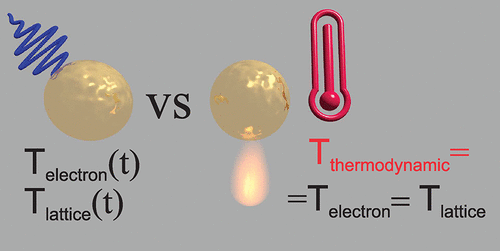当前位置:
X-MOL 学术
›
ACS Photonics
›
论文详情
Our official English website, www.x-mol.net, welcomes your feedback! (Note: you will need to create a separate account there.)
Thermometric Calibration of the Ultrafast Relaxation Dynamics in Plasmonic Au Nanoparticles
ACS Photonics ( IF 7 ) Pub Date : 2020-03-02 , DOI: 10.1021/acsphotonics.9b01605 Marzia Ferrera 1 , Giuseppe Della Valle 2 , Maria Sygletou 1 , Michele Magnozzi 1, 3 , Daniele Catone 4 , Patrick O’Keeffe 5 , Alessandra Paladini 5 , Francesco Toschi 5 , Lorenzo Mattera 1 , Maurizio Canepa 1 , Francesco Bisio 6
ACS Photonics ( IF 7 ) Pub Date : 2020-03-02 , DOI: 10.1021/acsphotonics.9b01605 Marzia Ferrera 1 , Giuseppe Della Valle 2 , Maria Sygletou 1 , Michele Magnozzi 1, 3 , Daniele Catone 4 , Patrick O’Keeffe 5 , Alessandra Paladini 5 , Francesco Toschi 5 , Lorenzo Mattera 1 , Maurizio Canepa 1 , Francesco Bisio 6
Affiliation

|
The excitation of plasmonic nanoparticles by ultrashort laser pulses sets in motion a complex ultrafast relaxation process involving the gradual re-equilibration of the system’s electron gas, lattice, and environment. One of the major hurdles in studying these processes is the lack of direct measurements of the dynamic temperature evolution of the system subcomponents. We measured the dynamic optical response of ensembles of plasmonic Au nanoparticles following ultra-short-pulse excitation, and we compared it with the corresponding static optical response as a function of the increasing temperature of the thermodynamic bath. Evaluating the two sets of data, the optical fingerprints of equilibrium or off-equilibrium responses could be clearly identified, allowing us to extract a dynamic thermometric calibration scale of the relaxation process, yielding the experimental ultrafast temperature evolution of the plasmonic particles as a function of time.
中文翻译:

等离子体金纳米粒子中超快弛豫动力学的温度标定
超短激光脉冲对等离子体纳米粒子的激发使复杂的超快速弛豫过程开始运动,该过程涉及系统电子气,晶格和环境的逐渐重新平衡。研究这些过程的主要障碍之一是缺乏直接测量系统子组件的动态温度。我们测量了超短脉冲激发后等离激元Au纳米粒子团的动态光学响应,并将其与相应的静态光学响应进行了比较,该响应是热力学浴温升高的函数。通过评估两组数据,可以清楚地识别出平衡或失衡响应的光学指纹,从而使我们能够提取弛豫过程的动态温度校准标度,从而得出等离激元粒子的实验超快温度演变。时间。
更新日期:2020-04-23
中文翻译:

等离子体金纳米粒子中超快弛豫动力学的温度标定
超短激光脉冲对等离子体纳米粒子的激发使复杂的超快速弛豫过程开始运动,该过程涉及系统电子气,晶格和环境的逐渐重新平衡。研究这些过程的主要障碍之一是缺乏直接测量系统子组件的动态温度。我们测量了超短脉冲激发后等离激元Au纳米粒子团的动态光学响应,并将其与相应的静态光学响应进行了比较,该响应是热力学浴温升高的函数。通过评估两组数据,可以清楚地识别出平衡或失衡响应的光学指纹,从而使我们能够提取弛豫过程的动态温度校准标度,从而得出等离激元粒子的实验超快温度演变。时间。


























 京公网安备 11010802027423号
京公网安备 11010802027423号